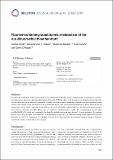Files in this item
Fluorine-containing substituents : metabolism of the α,α-difluoroethyl thioether motif
Item metadata
| dc.contributor.author | Rodil, Andrea | |
| dc.contributor.author | Slawin, Alexandra M. Z. | |
| dc.contributor.author | Al-Maharik, Nawaf | |
| dc.contributor.author | Tomita, Ren | |
| dc.contributor.author | O’Hagan, David | |
| dc.date.accessioned | 2019-07-17T09:30:02Z | |
| dc.date.available | 2019-07-17T09:30:02Z | |
| dc.date.issued | 2019-06-28 | |
| dc.identifier | 259649698 | |
| dc.identifier | 13103d5d-581a-46cf-9a1e-1ae09dbadf45 | |
| dc.identifier | 000473741300002 | |
| dc.identifier | 85068461028 | |
| dc.identifier.citation | Rodil , A , Slawin , A M Z , Al-Maharik , N , Tomita , R & O’Hagan , D 2019 , ' Fluorine-containing substituents : metabolism of the α,α-difluoroethyl thioether motif ' , Beilstein Journal of Organic Chemistry , vol. 15 , pp. 1441-1447 . https://doi.org/10.3762/bjoc.15.144 | en |
| dc.identifier.issn | 1860-5397 | |
| dc.identifier.other | RIS: urn:BD3863B807851129BC31216A10034E84 | |
| dc.identifier.other | ORCID: /0000-0002-9527-6418/work/59698717 | |
| dc.identifier.other | ORCID: /0000-0002-0510-5552/work/68281227 | |
| dc.identifier.uri | https://hdl.handle.net/10023/18107 | |
| dc.description | The Marie Curie-ITN Programme (FLUOR-21: Synthesis structure and function of fluorinated systems) is thanked for a Studentship (AR) and financial support. | en |
| dc.description.abstract | We report the metabolism of the recently introduced α,α-difluoroethyl thioether motif to explore further its potential as a substituent for bioactives discovery chemistry. Incubation of two aryl–SCF2CH3 ethers with the model yeast organism Cunninghamella elegans, indicates that the sulfur of the thioether is rapidly converted to the corresponding sulfoxide, and then significantly more slowly to the sulfone. When the substrate was (p-OMe)PhSCF2CH3, then the resultant (demethylated) phenol sulfoxide had an enantiomeric excess of 60%, and when the substrate was the β-substituted-SCF2CH3 naphthalene, then the enantiomeric excess of the resultant sulfoxide was 54%. There was no evidence of defluorination, unlike the corresponding oxygen ether (p-OMe)PhOCF2CH3, which was converted to the (demethylated) phenol acetate ester during C. elegans incubation. We conclude that the aryl–S–CF2CH3 motif is metabolised in a similar manner to aryl–SCF3, a motif that is being widely explored in discovery chemistry. It is however, significantly less lipophilic than aryl-SCF3 which may offer a practical advantage in tuning overall pharmacokinetic profiles of molecules in development. | |
| dc.format.extent | 7 | |
| dc.format.extent | 488354 | |
| dc.language.iso | eng | |
| dc.relation.ispartof | Beilstein Journal of Organic Chemistry | en |
| dc.subject | Cunninghamella elegans | en |
| dc.subject | Cytochrome P450 | en |
| dc.subject | Fluorinated substituents | en |
| dc.subject | Organofluorine metabolism | en |
| dc.subject | Sulfoxidation | en |
| dc.subject | QD Chemistry | en |
| dc.subject | NDAS | en |
| dc.subject.lcc | QD | en |
| dc.title | Fluorine-containing substituents : metabolism of the α,α-difluoroethyl thioether motif | en |
| dc.type | Journal article | en |
| dc.contributor.sponsor | European Commission | en |
| dc.contributor.institution | University of St Andrews. School of Chemistry | en |
| dc.contributor.institution | University of St Andrews. EaSTCHEM | en |
| dc.contributor.institution | University of St Andrews. Biomedical Sciences Research Complex | en |
| dc.identifier.doi | 10.3762/bjoc.15.144 | |
| dc.description.status | Peer reviewed | en |
| dc.identifier.grantnumber | 607787 | en |
This item appears in the following Collection(s)
Items in the St Andrews Research Repository are protected by copyright, with all rights reserved, unless otherwise indicated.

